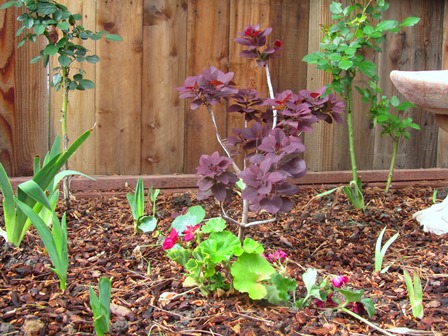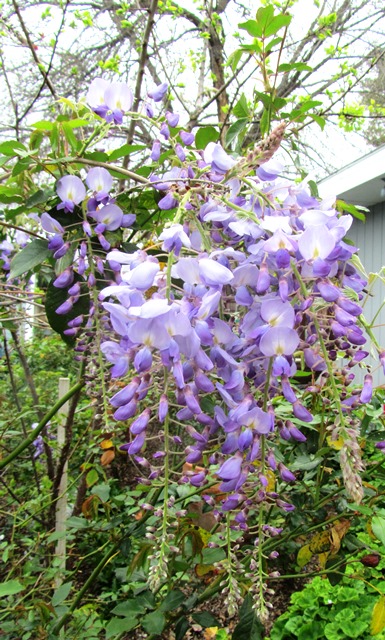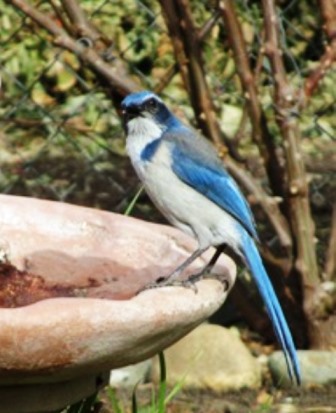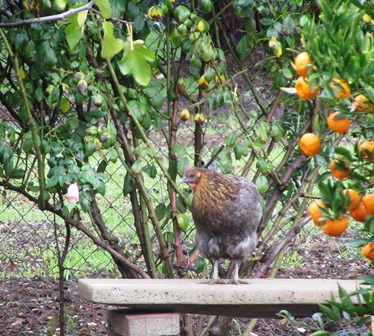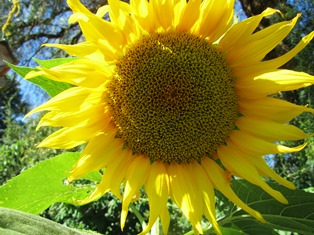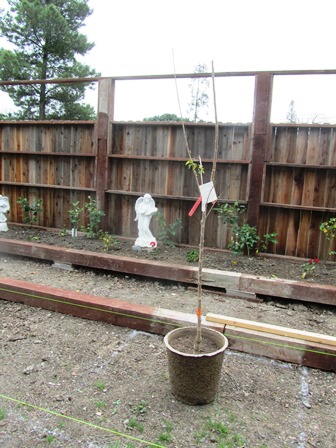Archive for March, 2015
Trying New Plants in the Garden
While some people might like to stick to tried-and-true types of plants in their gardens, I’ve always enjoyed experimenting with botanical specimens that are new to me. Recently, I purchased two smoke trees–plants I’ve never before cultivated.
The smoke tree’s value is in its satiny leaves that are blue-green or deep purple. In addition to the gorgeous round leaves (so very Feng Shui), the plant has very tiny flowers that appear in summer along feathery inflorescences that, in the purple variety, are nearly the same color as the leaves. The blue-green smoke trees have tiny yellow flowers.
The great thing about this plant is is adaptability to poor soil. That includes even rocky soil. The downside is that the plant requires pruning to achieve a denser tree since it tends to be open branching. The blooms appear when the wood of the tree is three years old. My trees are small, however, one already has sprouted the feathery inflorescences.
The smoke tree adds drama to shrub borders and mass plantings because of its dark color. I’ve placed it amid fuschia geraniums, purple and lavender irises, citrus trees, and Abbaye de Cluny roses. I also planted climbing Sally Holmes, which will cover the front fence with 3 1/2-inch creamy white blooms and dense green foliage.
The smoke tree tends to grow eighteen to twenty feet and its lovely purple color does not fade, even in intense summer heat. I look forward to many years of enjoyment, watching this tree take center stage in the long rectangular beds at the front of our farmette.
Flowers, Nest-Building, and Bee Swarms . . . Spring Has Arrived
The wisteria hangs in long purple bracts, its color finding resonance in the grape hyacinth blooms and the lavender buds. Delicate blossoms of pink and white create canopies of color for the fruit trees, and birdsong fills the air. Spring brings its gifts.
As the blue jay creates a screeching racket to the mockingbird’s ready song, the white-crowned sparrows have taken up residence in a row of birdhouses we’ve placed high on the back fence.The entrances of the sparrow houses are too small for the jay to access; a good thing since jays have earned a reputation as nest robbers.
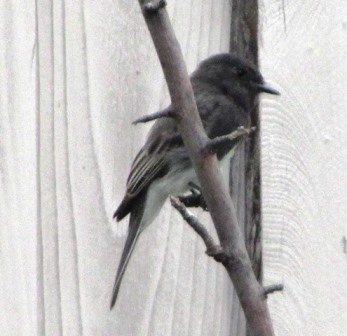
Crew Cut, our resident black phoebe, nests under an eve of the old chicken house; the male teaches its young to catch insects on the wing
Yesterday, I spotted the black phoebe pulling a piece of coir from a wall planter for its nest. These peaceful birds make a sound of tsip or fi-bee, fi-bee and can rise to roughly 50 feet to sing to a female.They range from California to central Texas, and even venture all the way to Argentina.
In the tallest eucalyptus on the acre that stands vacant behind our property, a pair of hawks are also nest-building. My farmette lies in their flight path. Not a good thing to see–hawks swooping down over my chickens and then rising to their lofty nest.
I threw some wildflower seed in beds over the weekend and then, after spotting my neighbor’s errant hen who flew to our yard, I began to regret my action. What can I do now but hope that she’ll not devour the seeds with her constant hunting and pecking?
Last night, I could have sworn I heard the pitter-patter of raindrops against the stone patio floor. With a steaming mug of coffee in hand at four o’clock this morning, I ventured outside and sure enough . . . it was still sprinkling. Hooray! It’s our first spring shower!
So, with all the nest-building and Mother Nature dropping a shower upon us, I know the wildflowers are blooming, too. That means the honeybee season is upon us. My neighbor has already had a bee swarm. I’m not ready, but I can’t stop Mother Nature from beginning a new cycle of seasons just because I don’t yet have my new honey frames assembled. That’s not how it works. Ready or not, spring has arrived.
Giant Sunflowers Provide Food and Fun for Everyone
Giant sunflowers need space to grow to full size; they can reach six or more feet tall. Bees love them for their pollen. Kids love them when the foliage of the plants create a secret fort or a fairy circle. Humans, birds, and squirrels love them for their seeds.
For best results, plant giant sunflowers at the back of a garden. They need good soil and full sun. Plant when the danger of frost has past. A rule of thumb to follow is to plant them about one inch deep and six inches apart. While the seeds are germinating, keep the soil moist.
Later on, when the plants stand about three inches tall, you can begin to thin them. Leave about one foot between each plant. This can enable a strong root system for form. The stalks will become sturdy and measure about three to four inches in circumference when fully grown.
First come the gorgeous petals in green to yellow and then bright yellow. As the bees pollinate the florets and they drop, the seeds will mature. Seeds are either gray or brown in color.
I always cut the heads when the seeds are plump, firm, and begin to drop. I let the heads dry well in the sun for days before I remove the seeds. Fully dry seeds can be stored in containers for human consumption or to be fed to the squirrels and birds.
* * *
If you enjoy reading about farmette topics (including gardening, beekeeping, and delicious recipes), check out my cozy mysteries A BEELINE TO MURDER and also THE MURDER OF A QUEEN BEE in the Henny Penny Farmette series (from Kensington Publishing).
These novels are available through online retailers such as Amazon, Barnes & Noble, Kobo Books, and Walmart as well as from traditional bookstores everywhere.
See, http://tinyurl.com/hxy3s8q
Now available in mass market paperback, this debut novel launched the Henny Penny Farmette series of mysteries and sold out its first press run.
See, http://tinyurl.com/h4kou4g
The second cozy mystery in the Henny Penny Farmette series, available Sept. 27, 2016
The Start of Something Wonderful . . . Spring!
I jumped at the chance to visit my favorite nursery this past weekend after my husband suggested a drive to Livermore, California. Alden Lane Nursery occupies a beautiful setting amid ancient oaks and there is even a honeybee hive on the premises. Wisteria blooms in perfusion there this time of year.
We came away with some pepper plants, two smoke trees, and four cherry trees, including Bing and Black Tartarian, its pollinator.
We are going to plant the cherry trees at the front of our property and the smoke trees will go in that area as well. We’ve done very little landscaping on the front of our land, preferring to get the trees and gardens in at the back near our hives and chicken run.
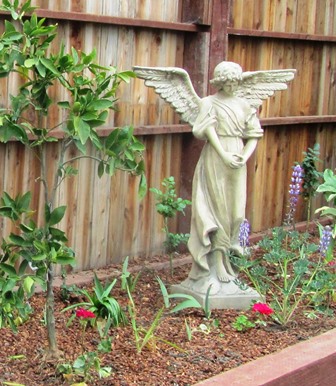
The beds that run the length of the fencing at the front of the farmette feature statuary, citrus, and bedding plants
Everywhere you look on the farmette, there are projects to be done. We chip away at them when we can. My husband works days and I write my novels, so the work will undoubtedly be never-ending. But that’s okay. We aren’t in a hurry and it’s easier to just live by the cycles and seasons of nature.
When I think of how the peaches and apricots are forming and the bees are almost ready to swarm, I know spring is here. And it’s my favorite season, so I’ll go outside, ignore the projects, have a cup of tea, and enjoy the start of something wonderful!
Time Out to Review My Copy-edited Manuscript
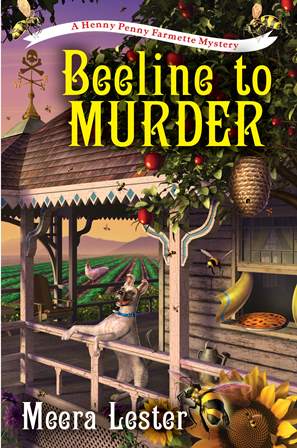
My debut novel, the first in a series of three cozy mysteries set against the backdrop of the Henny Penny Farmette
You may have noticed fewer blogs in recent days. And for good reason–my debut novel has just been copy-edited and I’m busy doing the the revisions.
I enjoy editing, so this is not only fun, but a learning experience for me. My attitude is to always try to learn as much as I can as I go through any new process. My editor is a dream and the copy editor is expert at what she does for authors’ books. I’m just plain lucky to be working with such talent.
I will be checking back soon with farmette goings-on. I have chicken issues that scream for my attention right now. The Rhode Island Red got a splinter in her foot and was limping around until I finally caught her. My husband removed the splinter and we treated her wound with antibiotic ointment.
Today, she seems fine, but another chicken has health problems. I’ve separated her from the rest and will be closely watching her.
So, I’m taking a little time away from all the farmette tasks to focus on the copy-edited manuscript. I want my readers to love the story of my sleuth, her coterie of friends, and the murder of the small town’s beloved pastry chef, Jean-Louis Bonheur. The book is in the pipeline and this is just one phase of the process. More on this to come later.
 Facebook
Facebook Goodreads
Goodreads LinkedIn
LinkedIn Meera Lester
Meera Lester Twitter
Twitter




